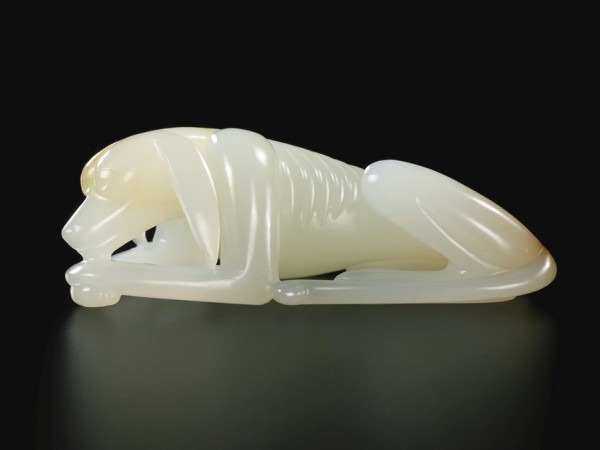
Yellow Jade dog, Ming Dynasty. Recumbent dog with its head turned towards its back, depicted with one paw on top of the other, the slender body detailed with ribs to the sides and a spine extending along the body and terminating with a curled tail, the warm greenish-yellow stone and its russet skin skillfully worked to render a brown lower body with a streak of russet to the left ear. Length 7 cm, 2 3/4 inch.

White Jade dog, Qing Dynasty, 18th century. Recumbent emaciated dog, depicted resting its head on its front paws, the head with a well-defined snout and flanked by a pair of long floppy ears, the slender body detailed with pronounced ribs flanking its vertebrae, its long tail curled to its left, the stone of a lustrous white color highlighted with russet inclusions and patches. Length 5.8 cm, 2 1/4 inch.
Jade carvings of hound-like dogs in a resting pose with outstretched legs can be found from as early as the Tang dynasty. Distinctive jade animals delicately carved in naturalistic poses were popular from the Song dynasty to the early Qing dynasty.
Their utilitarian function was as paperweights, but high-quality, sensitively rendered sculptures could also be kept as 'playthings' for scholars or wealthy patrons. In the best examples the natural interplay between various colors in the stone could be skillfully utilized in the rendering of the figure.
Dog figures from Song to early Ming dynasty could be found carved in yellow jade which is frequently found in the 14th and 15th century. Classic features of Song dog figures are the particularly sharply defined spine and ribs.
Published examples
Chinese Jade Animals, Hong Kong, 1996, cat. no. 68.
A crouching jade dog from the collection of Sir Joseph Hotung, attributed to the Song dynasty, is illustrated in Ip Yee, Chinese Jade Carving, Urban Council of Hong Kong and Hong Kong Museum of Art, Hong Kong, 1983, no. 134, and again by Jessica Rawson, Chinese Jade from the Neolithic to the Qing, London, 1995, pl. 26:10, where the author notes that 'hounds in jade may have been worn by those who wished to be known for their prowess in hunting' (p. 367).
White jade carving of a dog from the Zhirouzhai collection, attributed to the Song dynasty, included in the exhibition Exquisite Jade Carving, Art Gallery, The University of Hong Kong, Hong Kong, 1996, cat. no. 85,
A